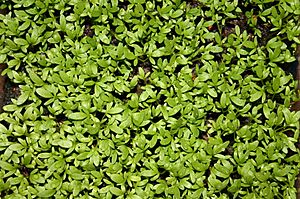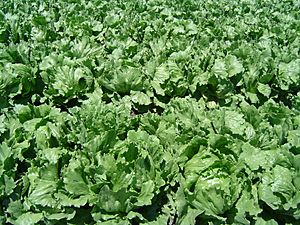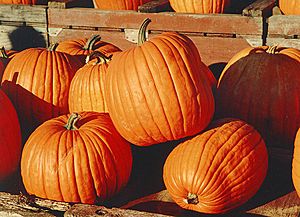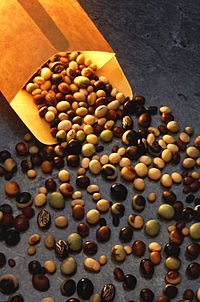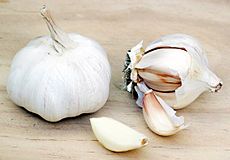List of vegetables facts for kids
A vegetable is a part of a plant that people eat as food. When we talk about "vegetables" in cooking, it's often different from how scientists (botanists) define them. For example, a tomato is actually a fruit in science, but we use it like a vegetable in our kitchens! This list focuses on plants we commonly call vegetables in cooking. It doesn't include herbs, spices, or most fruits and nuts that are usually eaten sweet.
Contents
Leafy and Salad Vegetables
These are vegetables where we eat the leaves! They are often used in salads, stir-fries, or cooked as greens. They are packed with vitamins and minerals.
| Species name | |
| Arrowhead elephant ear | Xanthosoma sagittifolium |
| Arugula | Eruca sativa |
| Beet (greens) | Beta vulgaris vulgaris |
| Bok choy (白菜) | Brassica rapa (chinensis) |
| Broccoli (leaves / stalks) | Brassica oleracea |
| Brussels sprouts | Brassica oleracea (gemmifera) |
| Cabbage | Brassica oleracea (capitata) |
| Celery | Apium graveolens |
| Chicory | Cichorium intybus |
| Collard greens | Brassica oleracea |
| Cress | Lepidium sativum |
| Dandelion | Taraxacum officinale |
| Endive | Cichorium endivia |
| Kale | Brassica oleracea (acephala) |
| Lettuce | Lactuca sativa |
| Malabar spinach | Basella alba |
| Miner's lettuce (Winter purslane) | Claytonia perfoliata |
| Mizuna greens | Brassica rapa (nipposinica) |
| Mustard | Sinapis alba |
| Napa cabbage | Brassica rapa (chinensis) |
| New Zealand Spinach | Tetragonia tetragonioides |
| Papaya leaves | Carica papaya |
| Radicchio | Cichorium intybus |
| Rapini (broccoli rabe) | Brassica rapa rapa |
| Spinach | Spinacia oleracea |
| Sweet potato leaves | Ipomoea batatas |
| Swiss chard | Beta vulgaris cicla (flavescens) |
| Taro leaves | Colocasia esculenta |
| Turnip greens | Brassica rapa (rapifera) |
| Watercress | Nasturtium officinale |
| Water spinach | Ipomoea aquatica |
Fruits Used as Vegetables
Even though these are botanically fruits (meaning they grow from the flower of a plant and contain seeds), we often cook and eat them like vegetables. Think of how you use a tomato in a salad or a pumpkin in a savory dish!
| Species name | |
| Breadfruit | Artocarpus altilis |
| Butternut squash | Cucurbita moschata |
| Bitter melon / Bitter gourd | Momordica charantia |
| Calabash / Bottle gourd | Lagenaria siceraria |
| Chayote | Sechium edule |
| Corn/Maize | Zea mays |
| Cooking banana / Plantain / Green banana | Musa × paradisiaca |
| Cucumber | Cucumis sativus |
| Eggplant / Aubergine / Brinjal | Solanum melongena |
| Jackfruit (unripe) | Artocarpus heterophyllus |
| Kabocha | Cucurbita maxima |
| Kiwano / Horned melon | Cucumis metuliferus |
| Luffa | Luffa cylindrica |
| Olive fruit | Olea europaea |
| Papaya (unripe) | Carica papaya |
| Pumpkin | Cucurbita |
| Squash | Cucurbita |
| Tinda | Praecitrullus fistulosus |
| Tomatillo | Physalis philadelphica |
| Tomato | Solanum lycopersicum |
| Water melon | Citrullus lanatus |
| Winter melon | Benincasa hispida |
| Zucchini / Courgette / Marrow | Cucurbita pepo |
Chili Peppers
Chili peppers are fruits from the Capsicum plant. They are known for their spicy flavor, which comes from a chemical called capsaicin. They come in many shapes, sizes, and heat levels!
| Species name | |
| Bell pepper | Capsicum annuum 'Bell' |
| Cayenne pepper | Capsicum annuum 'Cayenne' |
| Habanero | Capsicum chinense 'Habanero' |
| Jalapeño | Capsicum annuum 'Jalapeño' |
| Pimiento | Capsicum annuum 'Pimiento' |
Edible Flowers
Some flowers are not just pretty, they're also delicious! These flowers can add unique flavors and colors to dishes.

| Species name | |
| Artichoke | Cynara cardunculus / scolymus |
| Banana flower | Musa × paradisiaca, Musa acuminata, usa balibisiana, other bananas |
| Broccoli | Brassica oleracea |
| Calabaza flower | Cucurbita moschata |
| Caper | Capparis spinosa |
| Cauliflower | Brassica oleracea |
| Pumpkin flower | Cucurbita |
| Daylily | Hemerocallis fulva |
| Moringa | Moringa oleifera |
| Courgette flowers | Cucurbita |
| Squash blossoms | Cucurbita |
Podded Vegetables
Podded vegetables are plants where we eat the seeds or the pods that contain the seeds. These include many types of beans and peas. They are a great source of protein and fiber.
| Species name | |
| Asparagus bean | Vigna unguiculata (sesquipedalis) |
| Azuki bean | Vigna angularis |
| Black-eyed pea | Vigna unguiculata unguiculata |
| Chickpea | Cicer arietinum |
| Common bean | Phaseolus vulgaris |
| Drumstick | Moringa oleifera |
| Fava bean | Vicia faba |
| Green bean (French bean) | Phaseolus vulgaris |
| Hyacinth bean | Lablab purpureus |
| Lentil | Lens culinaris |
| Lima bean | Phaseolus lunatus |
| Mung bean | Vigna radiata |
| Okra | Abelmoschus esculentus |
| Pea | Pisum sativum |
| Peanut | Arachis hypogaea |
| Pigeon pea | Cajanus cajan |
| Runner bean | Phaseolus coccineus |
| Snap pea (sugarsnap, mangetout) | Pisum sativum (macrocarpon) |
| Snow pea (mangetout) | Pisum sativum (saccharatum) |
| Soybean | Glycine max |
| Winged bean | Psophocarpus tetragonolobus |
Bulb and Stem Vegetables
This group includes vegetables where we eat the underground bulb or the above-ground stem. These parts often store nutrients and have a unique crunch or flavor.
| Species name | |
| Asparagus | Asparagus officinalis |
| Cardoon | Cynara cardunculus |
| Celeriac | Apium graveolens (rapaceum) |
| Celery | Apium graveolens |
| Chives | Allium schoenoprasum |
| Florence fennel | Foeniculum vulgare (dulce) |
| Garlic | Allium sativum |
| Heart of palm | Cocos nucifera, Euterpe spp., Sabal spp., Bactris gasipaes, Deckenia nobilis, other palms |
| Kohlrabi | Brassica oleracea (gongylodes) |
| Lemongrass | Cymbopogon citratus |
| Leek | Allium porrum |
| Lotus root | Nelumbo nucifera |
| Onion | Allium cepa |
| Spring onion / Scallion | Allium wakegi |
| Shallot | Allium cepa (aggregatum) |
| Welsh onion | Allium fistulosum |
Root and Tuberous Vegetables
These vegetables grow underground. We eat their roots or tubers, which are swollen underground stems that store food for the plant. They are often starchy and filling.
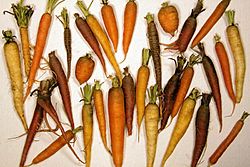
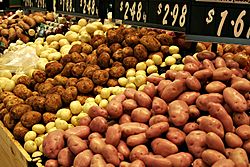
| Species name | |
| Arracacha | Arracacia xanthorrhiza |
| Bamboo shoot | Bambusa vulgaris, Phyllostachys edulis |
| Beetroot | Beta vulgaris vulgaris |
| Carrot | Daucus carota |
| Cassava | Manihot esculenta |
| Daikon | Raphanus sativus (longipinnatus) |
| Ginger | Zingiber officinale |
| Horseradish | Armoracia rusticana |
| Jerusalem artichoke | Helianthus tuberosus |
| Jícama | Pachyrhizus erosus |
| Parsnip | Pastinaca sativa |
| Potato | Solanum tuberosum |
| Radish | Raphanus sativus |
| Rutabaga (Swede) | Brassica napus (napobrassica) |
| Sweet potato (Kumara) | Ipomoea batatas |
| Taro | Colocasia esculenta |
| Turmeric | Curcuma longa |
| Turnip | Brassica rapa (rapifera) |
| Ube (Purple yam) | Dioscorea alata |
| Ulluco | Ullucus tuberosus |
| Wasabi | Wasabia japonica |
| Water caltrop | Trapa natans, Trapa bicornis |
| Water chestnut | Eleocharis dulcis |
| Yacón | Smallanthus sonchifolius |
| Yam | Dioscorea |
Sea Vegetables
These are plants that grow in the ocean, also known as seaweed. They are often used in Asian cuisine and are full of unique flavors and nutrients from the sea.
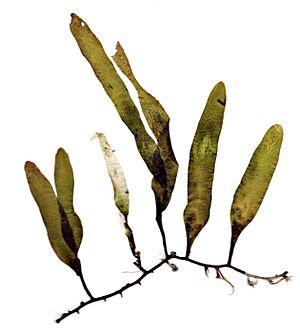
| Species name | |
| Aonori | Monostroma, Enteromorpha |
| Arame | Eisenia bicyclis |
| Dulse (Dillisk) | Palmaria palmata |
| Gim | Monostroma, Porphyra, Ulva |
| Hijiki | Hizikia fusiformis |
| Kombu | Laminaria japonica |
| Nori | Porphyra, Pyropia |
| Sea grape | Caulerpa lentillifera, Caulerpa racemosa |
| Sea lettuce | Ulva lactuca |
| Wakame | Undaria pinnatifida |
See also


